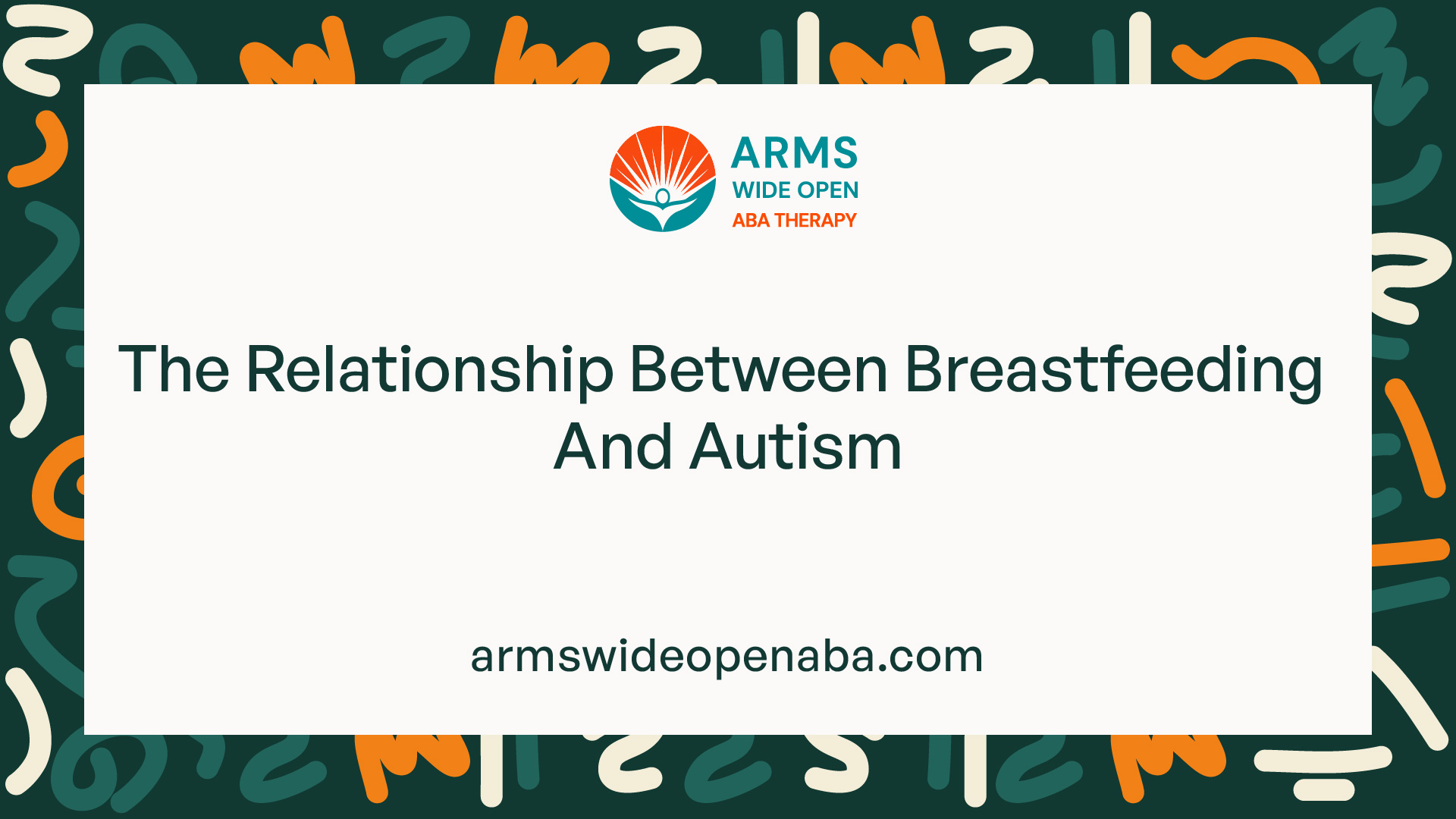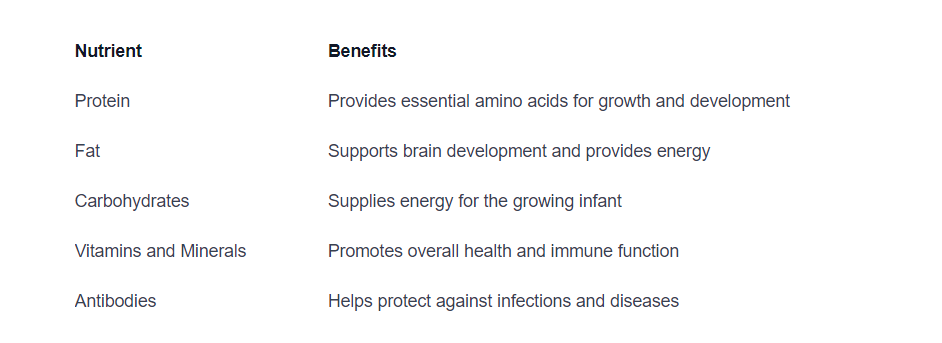The Relationship Between Breastfeeding And Autism
Unraveling the link between breastfeeding and autism. Explore the facts, myths, and potential benefits.

Breastfeeding and Autism: Understanding the Relationship
Breastfeeding has long been recognized as a beneficial practice for both infants and mothers. However, when it comes to the relationship between breastfeeding and autism, there are various perspectives and misconceptions that need to be addressed. In this section, we will explore the relationship between breastfeeding and autism, separating fact from fiction.

Introduction to Breastfeeding and Autism
Breastfeeding is the natural process of providing nourishment to infants through the mother's milk. It is widely acknowledged that breast milk is a rich source of essential nutrients and antibodies that support a baby's growth and development. However, the connection between breastfeeding and autism is a topic of ongoing research and debate.
Debunking Common Myths and Misconceptions
There are several myths and misconceptions surrounding the relationship between breastfeeding and autism that need to be dispelled. Let's examine a few of them:
- Myth: Breastfeeding prevents autism.
- Fact: While breastfeeding offers numerous health benefits to infants, there is no concrete evidence that it can prevent autism. Autism is a complex neurodevelopmental disorder influenced by a combination of genetic and environmental factors.
- Myth: Lack of breastfeeding causes autism.
- Fact: The decision to breastfeed or use formula does not cause autism. Autism is a multifactorial condition with a complex interplay of genetic and environmental factors. Breastfeeding is just one aspect of a child's early development.
- Myth: Breast milk composition causes autism.
- Fact: Breast milk is a dynamic substance that provides optimal nutrition for infants. It contains a variety of nutrients, antibodies, and bioactive components that support healthy growth and development. There is currently no scientific evidence linking breast milk composition to autism.
- Myth: Breastfeeding duration affects autism risk.
- Fact: Studies examining the relationship between breastfeeding duration and autism risk have produced mixed findings. While some studies suggest a potential protective effect of longer breastfeeding duration, others have not found a significant association. More research is needed to draw definitive conclusions.
It is important to approach the topic of breastfeeding and autism with an evidence-based perspective. While breastfeeding offers numerous benefits for infants, it is not a sole determinant in the development of autism. Understanding the complexities of autism and the factors that contribute to its onset is crucial for a comprehensive understanding of this condition.
The Research on Breastfeeding and Autism
When examining the relationship between breastfeeding and autism, it is important to explore the existing research and understand the findings. Numerous studies have been conducted to investigate this topic, shedding light on the potential links between breastfeeding and autism spectrum disorder (ASD).
Overview of Studies and Findings
Several studies have been conducted to explore the relationship between breastfeeding and the risk of developing autism. The findings are varied and inconclusive, making it difficult to establish a clear cause-and-effect relationship. Here is an overview of some of the key studies conducted:

It is important to note that these studies provide only a glimpse into the complex relationship between breastfeeding and autism. While some studies suggest a potential protective effect of breastfeeding against autism, others have found no significant association. The results are often influenced by various factors, including study design, sample size, and the inclusion of confounding variables.
Limitations and Confounding Factors
It is crucial to acknowledge the limitations and confounding factors that impact the research on breastfeeding and autism. Some common limitations include:
- Study Design: The majority of studies are observational in nature, which means they rely on self-reported data and retrospective analysis. This can introduce bias and limit the ability to establish causality.
- Sample Size: The size of the study sample can vary significantly, which affects the statistical power and generalizability of the findings.
- Confounding Variables: Factors such as maternal age, education, socioeconomic status, and genetic predisposition can influence both breastfeeding practices and the risk of autism. Controlling for these confounding variables is challenging.
- Recall Bias: Retrospective studies rely on participants' ability to recall and accurately report their breastfeeding history, which can be subject to memory bias.
- Publication Bias: Studies with positive findings may be more likely to be published, leading to an overestimation of the association between breastfeeding and autism.
Given these limitations, it is important to interpret the research findings with caution. More robust and well-controlled studies are needed to further explore the relationship between breastfeeding and autism. Additionally, it is crucial to consider the multifactorial nature of autism, as genetics and environmental factors play significant roles in its development.
Understanding the existing research is important, but it is equally essential to consider the larger picture of autism etiology and risk factors. Breastfeeding provides numerous benefits for both mother and infant, and while its potential impact on autism risk is still uncertain, it remains an important aspect of early childhood development and overall maternal-infant health.
Potential Benefits of Breastfeeding for Autism
When examining the relationship between breastfeeding and autism, it's important to consider the potential benefits that breastfeeding may provide. While more research is needed to fully understand this complex topic, there are a few areas where breastfeeding may have a positive impact on autism.
Nutritional Benefits of Breast Milk
Breast milk is often referred to as "liquid gold" due to its unique composition and nutritional value. It contains a wide range of essential nutrients, antibodies, and bioactive compounds that support the growth and development of infants.

Breast milk is specifically tailored to meet the nutritional needs of infants, providing them with a strong foundation for healthy development. While the direct impact of these nutrients on autism risk is still being studied, the general health benefits of breastfeeding can contribute to a child's overall well-being.
Maternal-Infant Bonding and Social Interaction
Breastfeeding fosters a unique bond between a mother and her infant, promoting maternal-infant bonding and social interaction. The close physical contact, eye contact, and skin-to-skin contact during breastfeeding can enhance emotional connection and communication between the mother and child.
This bonding experience may have indirect benefits for the child's social and emotional development, which are important factors in autism. The nurturing and responsive care provided during breastfeeding can contribute to the child's sense of security, trust, and emotional regulation.
Furthermore, breastfeeding can create opportunities for social interaction and communication, as infants often gaze at their mother's face and respond to her voice and touch during breastfeeding. These early social experiences may play a role in the development of social skills and social cognition, which are areas of interest in autism research.
While breastfeeding has potential benefits for the development and well-being of infants, it's important to note that it is just one factor among many that influence autism risk. Genetic and environmental factors, as well as other influences, also play significant roles. As research continues to explore the relationship between breastfeeding and autism, it's important to approach the topic with an open mind and consider multiple factors that contribute to the development of autism spectrum disorders.
Factors to Consider
When examining the relationship between breastfeeding and autism, it's important to consider various factors that may influence the development of autism in children. While breastfeeding has been the subject of research in relation to autism, it is crucial to understand that autism is a complex condition influenced by multiple genetic and environmental factors.
Genetic and Environmental Factors
Autism is known to have a strong genetic basis. Research suggests that certain genes are associated with an increased risk of autism spectrum disorder (ASD). However, it's important to note that genetics alone do not determine the development of autism. Environmental factors also play a significant role.
Studies have identified a range of genetic variations that may contribute to the risk of developing autism. These variations can affect various biological pathways involved in brain development, synaptic function, and neuronal connectivity. However, further research is needed to fully understand the complex interplay between genetics and autism.
In addition to genetic factors, environmental influences have been implicated in the development of autism. Prenatal and early life factors such as maternal health, exposure to certain chemicals, medications, and infections during pregnancy, as well as birth complications, have been explored as potential contributors to autism risk. However, it's important to note that these factors are not specific to breastfeeding and can affect children regardless of their feeding method.
Other Influences on Autism Risk
While breastfeeding has been the subject of research in relation to autism, it's crucial to recognize that it is just one piece of the puzzle. Other factors, such as socioeconomic status, parental education, and access to healthcare, can also influence the risk of autism.
Research has shown that children from disadvantaged backgrounds may have a higher prevalence of autism. This may be due to a combination of genetic and environmental factors, as well as limited access to early intervention services and resources.
It's important to approach the relationship between breastfeeding and autism within the broader context of autism research. Understanding the interplay between genetic and environmental factors, as well as considering other influences on autism risk, can help provide a more comprehensive understanding of this complex condition.
By considering these factors, researchers can continue to explore the relationship between breastfeeding and autism, and work towards a better understanding of the various factors that contribute to autism spectrum disorder.
Factors to Consider
While there has been ongoing research exploring the relationship between breastfeeding and autism, it's important to consider various factors that may contribute to the development of autism. Understanding these factors can provide a more comprehensive view of the topic.
Genetic and Environmental Factors
Autism is a complex neurodevelopmental condition influenced by both genetic and environmental factors. Research suggests that genetic predisposition plays a significant role in the development of autism. Certain gene mutations and variations have been associated with an increased risk of autism.
However, it's essential to note that genetics alone do not determine whether a child will develop autism. Environmental factors also contribute to the risk. These factors include prenatal and perinatal conditions, exposure to certain substances during pregnancy, and early life experiences. Breastfeeding, while important for infant health, is just one factor among many that can influence autism risk.
Other Influences on Autism Risk
Several other factors have been investigated for their potential influence on autism risk. These factors include maternal age, maternal health, socioeconomic status, and prenatal care. It's important to recognize that these factors interact with each other and with genetics in complex ways, making it challenging to pinpoint a single cause or relationship between breastfeeding and autism.
Research in this area is ongoing, and while some studies have suggested a possible association between breastfeeding and reduced autism risk, further investigation is needed to establish a clear causal relationship.
Understanding the various factors that contribute to autism risk is crucial for providing a comprehensive view of the condition. Breastfeeding, as an important aspect of infant nutrition and maternal-infant bonding, plays a role in child development. However, it is essential to consider the broader context of genetic and environmental influences when exploring the relationship between breastfeeding and autism.
Sources
https://www.thetreetop.com/aba-therapy/breastfeeding-and-autism#
https://www.nature.com/articles/s41598-022-27040-x
https://www.ncbi.nlm.nih.gov/pmc/articles/PMC8746572/
Similar articles
We’re here to help you

Our team is here to assist you in this process. Contact us for any assistance.
it’s easy to apply
We Accept Most Insurances
Our in-network insurance partnerships make ABA therapy more accessible to families throughout our service areas.







Our Insurance Process
We'll request your insurance details to help us verify your plan's coverage for ABA therapy. Once we've received this information, we'll walk you through your benefits, including copayments, deductibles and out-of-pocket maximums, so you know what to expect in advance.
Our team will then handle the preauthorization and all the necessary paperwork.
.svg)





















.jpeg)


































.jpeg)




.jpeg)







.jpeg)











.jpeg)
















